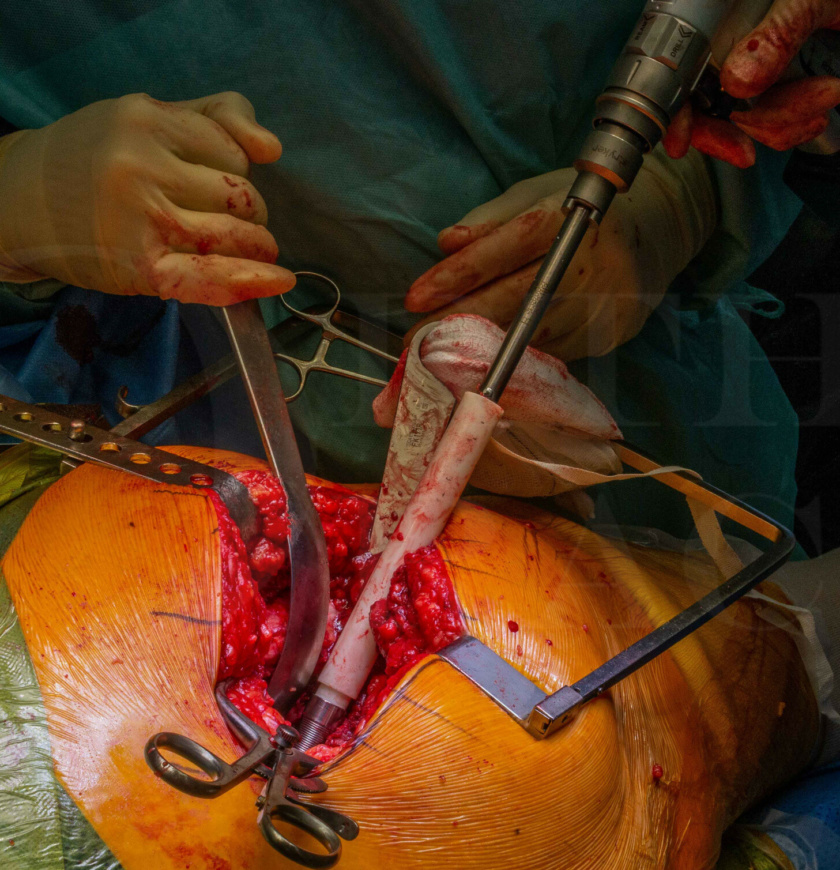Total Hip Replacement(posterior approach): Corail stem and Pinnacle acetabulum (DePuy-Synthes)
Overview

Subscribe to get full access to this operation and the extensive Hip Surgery Atlas.
Professional Guidelines Included
Learn the Total Hip Replacement(posterior approach): Corail stem and Pinnacle acetabulum (DePuy-Synthes) surgical technique with step by step instructions on OrthOracle. Our e-learning platform contains high resolution images and a certified CME of the Total Hip Replacement(posterior approach): Corail stem and Pinnacle acetabulum (DePuy-Synthes) surgical procedure.
Total hip replacement (THR) is one of the most successful orthopaedic surgical procedures for the treatment of advanced degenerative hip disease. Patients undergoing THR experience increased mobility, improved function, sustained pain relief, and improved quality of life. There are a number of different fixation options available to orthopaedic surgeons including cemented and cementless hip constructs.
Whilst cementing has been used for many decades and demonstrates good implant survival rates it exposes the patient to the possibility of bone cement implantation syndrome, increases the operative time, restricts the bearing choices and potentially has inferior survival characteristics, particularly on the acetabular side.
One of the most widely used cementless hip implant systems is the Corail hip stem with the Pinnacle acetabular system (Corail Pinnacle construct) from DePuy Synthes. It is an ODEP 10A rated system and has NJR data going back to its inception in 2003. It is my preference to use an uncemented system in younger patients where the anatomy is relatively ‘normal’. In post-menopausal women and patients over 70 I use a hybrid construct with a Pinnacle cup and cemented C-stem AMT (DePuy Synthes). This is identified by GIRFT as best practice and reduces the risk of an intra-operative fracture and potentially reduces total cost taking into account the patient’s age and likelihood of needing a revision. In all bearing combinations (excluding metal on metal) the standard offset collared Corail Pinnacle combination performs at least as well if not better than the class comparator.
The cementless stem is available both with and without a collar. Proponents of the use of a collared prosthesis claim that it provides advantages in the early stability of the implant, allowing for earlier post-operative weight bearing, protection against subsidence, and a positive dispersion of the vertical forces via the collar into the medial calcar. The NJR has recently produced updated analysis examining the performance of the Corail total hip system, specifically the collared Corail stem in combination with the Pinnacle cup. The report demonstrates statistically significantly fewer revisions than all other cementless hips (including the collarless Corail stem) across a range of revision reasons, including pain, dislocation and peri-prosthetic fracture (all p<0.001).
The Pinnacle acetabular cup system includes an acetabular option with a high friction coating. This Gription coating exhibits a proprietary gradient porosity which is engineered with a clinically advantageous 63% surface volume porosity designed to facilitate bone in-growth and a favourable mechanical loading environment for bone formation. The Pinnacle cup with Gription coating has a cumulative revision rate at 9 years of 2.7% (2.3, 4.5%). This is a low revision rate and compares favourably with the cumulative revision rate for all other cementless cups at 9 years of 3.1% (3.0, 3.1%). The adjusted hazard ratio is 1.10 (0.97, 1.24) p=0.136 indicating that there is no statistically significant difference in risk of revision.
The technical aspects of the procedure and posterior hip approach are similar to other hip replacements and readers will find the following OrthOracle operative techniques also of interest:
Total Hip replacement: Exeter femoral stem and Tritanium acetabular component (Stryker)
Total Hip replacement: Cemented Exeter/Contemporary (Stryker) by a posterior approach
Total Hip Replacement: Birmingham Hip resurfacing (Smith and Nephew)
Total Hip replacement: C stem AMT/Elite (Depuy) cemented hip (femur first)
Total Hip replacement (Midi-posterior approach): Corail Pinnacle (De Puy)
Author: James Donaldson FRCS (Tr & Orth)
Institution: The Royal National Orthopaedic Hospital, Stanmore, London, UK.
Clinicians should seek clarification on whether any implant demonstrated is licensed for use in their own country.
In the USA contact: fda.gov
In the UK contact: gov.uk
In the EU contact: ema.europa.eu



















